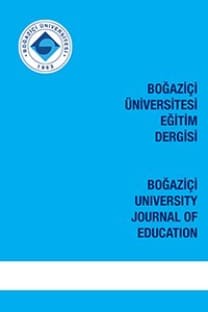Learning How to Spell in Turkish
Öz
In comparison to the large body of research on reading and its underlying processes in the field of literacyacquisition, the number of studies investigating the components of writing has remained rather limited(Treiman, 1993). Given that spelling is a fundamental aspect of the ability to write, understanding the natureof spelling may contribute to improvements in literacy instruction, in particular, for those who experiencelearning difficulties. The course of spelling development has been mostly studied in English (Ehri, 1986;Frith, 1980; Gentry, 1982; Henderson, 1985), a language known for its opaque orthography. In recent workthere appears to be a growing interest to investigate spelling patterns in relatively transparent orthographiessuch as German (Wimmer & Hummer, 1990) and Czech (Caravolas, Volin & Hulme, 2005). However, onlyfew studies to date have dealt with spelling performance in transparent orthographies such as Finnish(Lehtonen, 2006) and Turkish (e.g., Babayiğit & Stainthorp, 2007; Erden, Kurdoğlu, & Uslu, 2002). Theprimary purpose of the present paper is to examine spelling development in Turkish across grades 1-3. Wecompared results obtained from different tasks (e.g., single word, sentence and text spelling tasks based onauditory and visual prompts) based on a comprehensive error categorization. Spelling performance inTurkish is analyzed both quantitatively and qualitatively; and the findings are discussed in terms ofdevelopment of spelling across grades and characteristics of error types according to varying spelling taskdemands. The most common error type was found to be grapheme substitution, followed by graphemeomission; and auditory prompts yielded more errors when compared to visual prompts, which was anexpected outcome. Some implications are made regarding the role of universal processes and languagespecific characteristics in the emergence of spelling errors.
Anahtar Kelimeler:
Error types, Spelling, Transparent Orthography, Turkish
___
- Aşlıyan, R., Günel, K., & Filiz, A. (2006). Türkçe Otomatik Heceleme Sistemi ve Hece İstatistikleri, Akademik Bilişim+ BilgiTek IV Konferansı, Pamukkale Üniversitesi, Denizli.
- Aydın, Ö. (2012). Elifbâdan alfabeye: İki yazı sisteminde yazıbirim-sesbirim etkileşimi. ODTÜ Gelişme Dergisi, 39, 61-86.
- Babayigit, S. & Stainthorp, R. (2007). Preliterate phonological awareness and early literacy skills: Evidence from Turkish. Journal of Research in Reading, 30, 394-413.
- Bosman, A. M. T. & Van Orden, G. C.(1997). Why spelling is more difficult than reading. In C. A. Perfetti, L.Rieben ve M. Fayol, (Eds.), Learning to spell: Research, theory, and practice across languages (pp. 173-194). Hillsdale, NJ: Lawrence Erlbaum Associates.
- Bryant, P.E., MacLean, M., Bradley, L.L. & Crossland, J. (1990). Rhyme and alliteration, phoneme detection, and learning to read. Developmental Psychology, 26, 429-438.
- Caravolas, M., Volin, J. & Hulme, C. (2005). Phoneme awareness is a key component of alphabetic literacy skills in consistent and inconsistent orthographies: Evidence from Czech and English children. Journal of Experimental Child Psychology, 92(2), 107-139.
- Durgunoglu, A.Y.& Öney, B. (1999). A cross-linguistic comparison of phonological awareness and word recognition. Reading & Writing, 11, 281-299.
- Ehri, L. C. (1986). Sources of difficulty in learning to spell and read. Advances in developmental and behavioral pediatrics, 7, 121-195.
- Erden G., Kurdoğlu F. & Uslu, R. (2002). İlköğretim okullarına devam eden Türk çocuklarının sınıf düzeylerine göre okuma hızı ve yazım hataları normlarının geliştirilmesi. Türk Psikiyatri Dergisi, 13(1), 5-14.
- Ergenç, İ. (1991). <ğ> üzerine. In A. Sezer, A. ve S. Koç, (Eds.), Dilbilim Yazıları (pp. 51-56). Usem Yayınları, Ankara.
- Frith, U. (1980). Unexpected spelling problems. In U. Frith (Ed.), Cognitive processes in spelling (pp. 495-516). London: Academic Press.
- Gentry, J.R. (1982). An analysis of developmental spelling in GNYS AT WRK. The Reading Teacher, 36, 192-200.
- Henderson, E. (1985). Teaching spelling. Boston: Houghton Mifflin.
- Ingram, D. (1974). Phonological Rules in Young Children. Journal of Child Language, 1, 49-64
- Lancaster, L. (2003). Moving into Literacy: How it all begins. In R. M. Joshi ve P. G. Aaron (Eds.), Handbook of orthography and literacy (pp. 145-153). Mahwah, NJ: Erlbaum.
- Lehtonen, A. (2006). The sources of information children use in learning to spell: The case of Finnish geminates. In R. M. Joshi ve P. G. Aaron (Eds.), Handbook of orthography and literacy (pp. 63-79). Mahwah, NJ: Erlbaum.
- Liberman, I., Liberman, A.M., Mattingly, I. & Shankweiler, D. (1980). Orthography and the Beginning Reader. In J.F. Kavanagh ve R.L. Venezky (Eds.) Orthography, Reading, and Dyslexia (pp. 137-153).University Park Press: Baltimore.
- Oktay, A. & Aktan, K. E. (2002). A Cross-linguistic Comparison of Phonological Awareness and Word Recognition in Turkish and English. International Journal of Early Years Education, 10(1), 37-48.
- Öney, B. &Durgunoglu, A.Y. (1997). Beginning to read in Turkish: A phonologically transparent orthography. Applied Psycholinguistics, 18, 1-15.
- Perfetti, C. A. (1997). The psycholinguistics of spelling and reading. In C. A.Perfetti, L. Rieben, & M. Fayol (Eds.), Learning to spell: Research, theory, and practice across languages (pp.21-38). Mahwah, NJ: Erlbaum.
- Read, C. (1975). Children’s categorization of speech sounds in English. Urbana, IL: National Council of Teachers of English.
- Read, C. (1986). Children’s creative spelling. London: Routledge & Kegan Paul. Seymour, P.H.K., Aro, M., ve Erskine, J.M. (2003). Foundation literacy acquisition in European orthographies. British Journal of Psychology, 94, 143-174.
- Treiman, R. (1993). Beginning to spell: A study of first-grade children. New York: Oxford University Press.
- Treiman, R. (2006). Knowledge about letters as a foundation for reading and spelling. In R. M. Joshi ve P. G. Aaron (Eds.), Handbook of orthography and literacy (pp. 581-599). Mahwah, NJ: Erlbaum.
- Wimmer, H. & Goswami, U. (1994). The influence of orthographic consistency on reading development: Word recognition in English and German children. Cognition, 51, 91-103.
- Wimmer, H. & Hummer, P. (1990). How German speaking first graders read and spell: Doubts on the importance of the logographic stage. Applied Psycholinguistics, 11, 349-368.
- ISSN: 1300-9567
- Yayın Aralığı: 3
- Başlangıç: 1976
- Yayıncı: Boğaziçi Üniversitesi
Sayıdaki Diğer Makaleler
Ali DELİCE, Emin AYDIN, Gökhan DERİN, Ömer YAŞIN
Learning How to Spell in Turkish
